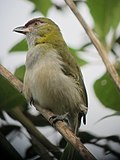| Peppershrikes | |
|---|---|
 | |
| Rufous-browed peppershrike (Cyclarhis gujanensis) | |
| Scientific classification | |
| Kingdom: | Animalia |
| Phylum: | Chordata |
| Class: | Aves |
| Order: | Passeriformes |
| Family: | Vireonidae |
| Genus: | Cyclarhis Swainson, 1824 |
| Type species | |
| Tanagra gujanensis Gmelin, JF, 1789 | |
| Species | |
The peppershrikes are two species of passerine bird found in tropical Central and South America. They form the genus Cyclarhis, part of the vireo family.
Contents
These are heavyset birds with a hooked shrike-like bill. Although sluggish and very vocal, the peppershrikes are still difficult to spot as they feed on insects and spiders in the canopy aloft. Their cup-shaped nests can likewise be found high in the trees.









